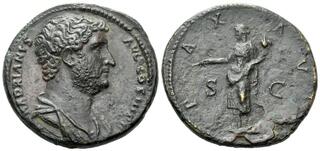| Naville Numismatics Ltd. > Auction 88 | Auction date: 7 April 2024 |
| Lot number: 440 Price realized: Unsold | Show similar lots on CoinArchives Find similar lots in upcoming auctions on |
| Lot description: Hadrian, 117-138 Sestertius, work of the 'Alphaeus master' Rome circa 133-135, Æ 34.00 mm., 21.24 g. Bare-headed and draped bust r. Rev. Pax standing l., holding branch and cornucopiae; S-C across fields. C 1016. BMC 1528. RIC 2167 (these dies) cf. NAC 54, 432 (these dies and sold for 95'000 CHF) Excessively Rare; the work of the 'Alphaeus master'. An extraordinary portrait work of an excellent master engraver. Brown tone, bold portrait, minor areas of corrosions and cuprite gently levelled out in parts, otherwise Good very fine Among the great prizes of Roman coinage are medallic sestertii which Charles Seltman attributed to an artist he dubbed the 'Alphaeus Master'. This engraver may have been the sculptor Antonianus of Aphrodisias, whose style epitomised the Hadrianic revival of Greek classicism, but with that speculation aside we may say he is the most celebrated die engraver of the Roman period to have been identified by his body of work. We might suspect he was a member of the inner circle of Hadrian, an emperor who was so completely infatuated with Greek art and culture that he would have made Greece his home had his obligations not interfered. He became familiar with Athens as a young man, and in 112 was elected archon of the city; as emperor he travelled to Greece in 124/5, 128 and 131, typically residing in his favourite city, Athens. This sestertius very likely was struck in 135 for Hadrian's vicennalia (20th anniversary). The selection of Pax as the reverse type may well be a reference to the emperor's hope for a speedy end to the Bar Kochba War in Judaea – a traumatic event that tarnished the last years of Hadrian's life. Toynbee describes these sestertii as 'medallic coins', for in her view they pair a regular reverse die for a sestertius with a portrait die intended to produce bronze medallions. Though it cannot be disproven that the reverse die was intended for standard coinage (after all, it does include SC in the inscription), the artistry is of such a high calibre it is hard to imagine that it was ever intended to produce regular-issue sestertii. Two bronze medallions in Gnecchi (pl. 42, nos. 3, 4) bear portraits that Toynbee rightly ascribes to the Alphaeus Master. The first is of a different die than the one used for the Pax sestertius and is paired with an anepigraphic reverse displaying the birds of the Capitoline Triad; the second appears to share the obverse die of the Pax sestertius, though in this case it is paired with an anepigraphic reverse showing a bridge with its span decorated with eight columns. Among other imperial issues produced by the Alphaeus Master we should add a bronze medallion showing on its reverse the forest-god Silvanus bringing a goat before a temple entrance (NAC 15, lot 355) and a silver medallion showing Athena and Poseidon in their competition to be the patron of Athens (NAC 18, lot 519). Other portraits of Hadrian of different composition might also be considered, as should some unusually refined reverse dies for bronze medallions (for example, Gnecchi II pl. 38, nos. 5 and 6; pl. 40, nos. 5-8; pl. 41, no. 2; and pl. 42, nos. 1 and 5). Starting price: 7000 GBP |  |


